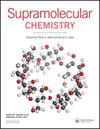Predicting the hydrolytic breakdown rates of organophosphorus chemical warfare agent simulants using association constants derived from hydrogen bonded complex formation events
IF 2.6
4区 化学
Q3 CHEMISTRY, MULTIDISCIPLINARY
引用次数: 1
Abstract
ABSTRACT Organophosphorus (OP) chemical warfare agents (CWAs) represent an ongoing global threat, through either purposeful environmental release or the need to dispose of historic stockpiles. This presents a need for the development of novel decontamination technologies. Due to the toxic nature and legal limitations placed on OP CWAs, the use of appropriate OP simulants that mimic the reactivity but not the toxicity of the agents themselves is vital to decontamination studies. Herein, we show that association constants derived from non-specific hydrogen bonded complexation events may be used as parameters within models to predict simulant reactivity. We also discuss the limitations that should be placed on such data. GRAPHICAL ABSTRACT利用氢键络合物形成事件得出的缔合常数预测有机磷化学战剂模拟物的水解分解速率
有机磷(OP)化学战剂(CWAs)是一种持续的全球威胁,无论是通过有目的的环境释放还是需要处理历史库存。这就提出了开发新型去污技术的需要。由于有机磷化学物质的毒性和法律限制,使用适当的有机磷化学物质模拟物来模拟反应性,而不是模拟药剂本身的毒性,这对净化研究至关重要。在此,我们证明了非特异性氢键络合事件得出的结合常数可以用作模型中的参数来预测模拟反应性。我们还讨论了应该对此类数据施加的限制。图形抽象
本文章由计算机程序翻译,如有差异,请以英文原文为准。
求助全文
约1分钟内获得全文
求助全文
来源期刊

Supramolecular Chemistry
化学-化学综合
CiteScore
3.60
自引率
3.00%
发文量
5
审稿时长
2.7 months
期刊介绍:
Supramolecular Chemistry welcomes manuscripts from the fields and sub-disciplines related to supramolecular chemistry and non-covalent interactions. From host-guest chemistry, self-assembly and systems chemistry, through materials chemistry and biochemical systems, we interpret supramolecular chemistry in the broadest possible sense. Interdisciplinary manuscripts are particularly encouraged. Manuscript types include: high priority communications; full papers; reviews, and; Methods papers, techniques tutorials highlighting procedures and technologies that are important to the field. We aim to publish papers in a timely fashion and as soon as a paper has been accepted and typeset it will be published in electronic form on the Latest articles section of the website. The two most important review criteria are that the paper presents high-quality work that fits generally into the broad spectrum of activities in the supramolecular chemistry field. Under normal circumstances, Supramolecular Chemistry does not consider manuscripts that would be more suitable in a highly specialized journal. This includes, but is not limited to, those based mostly or exclusively on topics such as solid state/X-ray structures, computational chemistry, or electrochemistry. .
The two most important review criteria are that the paper presents high-quality work that fits generally into the broad spectrum of activities in the supramolecular chemistry field.
 求助内容:
求助内容: 应助结果提醒方式:
应助结果提醒方式:


